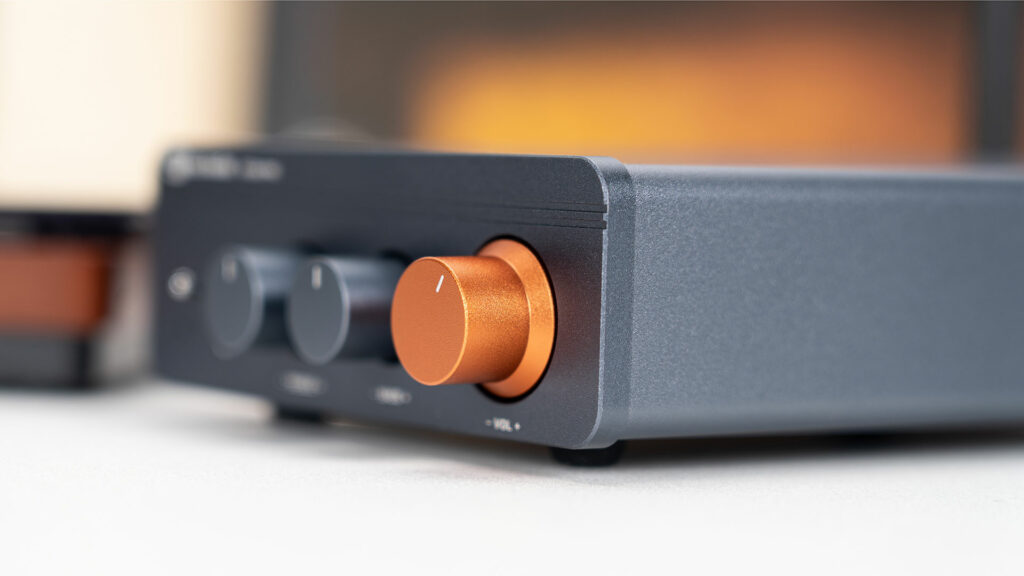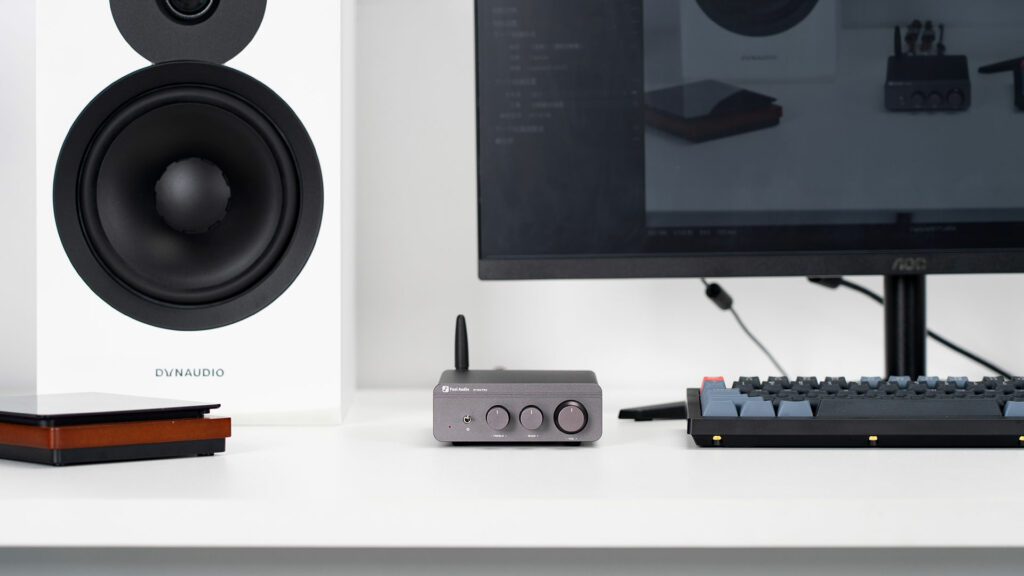The first review published in Future Audiophile was an SMSL integrated amplifier (read the review) that cost less than $175. It is a great little amp with an extensive input and feature set in a small chassis. Today, I’m going to look at another even less expensive power amplifier priced at under $100 from Fosi. It offers even fewer inputs but much greater power specs, so it can handle a wider variety of loudspeakers. If your old AV receiver or power amplifier is beginning to sound not so good, the Fosi BT20A preamplifier (buy at Amazon) might be your perfect inexpensive upgrade solution.

What Makes the BT20A Pro Integrated Amplifier Special?
- The BT20A Pro is rated to produce just shy of 150 watts RMS into a 4-ohm load using a Texas Instruments TPA3255 chip and the optional 48-volt power supply. You can also opt for the 32-volt power supply for less money, but it reduces the power output to around 70 watts per side into 4-ohms. The review sample came with the 32-volt power supply brick. At this price, there is no reason to skimp on the power supply.
- The Fosi BT20A Pro offers the option to swap op amps. The two plug-in sockets inside can be replaced by several different NE5532 op amps, including a MUSES02, OPA2604AP, or OPA2134PA. According to Fosi, each op amplifier has a slightly different sound character.
- The Fosi BT20A Pro includes a Bluetooth 5.0 input in addition to one pair of single-ended RCA inputs. The Bluetooth input has a memory for the last BT source but can be easily reprogrammed for a new Bluetooth source.
- The Fosi BT20A Pro includes treble and bass controls with a central detent so they can easily be reset to the neutral position. There is also a line-level output linked to the volume control so you can easily add a subwoofer.
- The Fosi BT20A Pro draws only 2.5 Watts of power during idle. Also, it barely gets warm even when driving speakers for long periods of time. The best modern electronics are far more energy efficient that amps from the past. This Fosi sips power, which is nice.
- The Fosi BT20A Pro has two volume knob options: carrot orange or dark gray. It’s a little thing, but given that I have such a preference for the gray over the orange my review unit was equipped with, it’s obvious that little aesthetic things like this matter.
Why Should You Care About the Fosi BT20A Pro Integrated Amplifier?
There have always been inexpensive audiophile integrated amplifiers available for audio enthusiasts on a tight budget. Unfortunately, most don’t perform at a level that’s acceptable for anything but low volume background music or basic sound reinforcement. The Fosi BT20A Pro performs on a level that puts it squarely into a different category of amplifier: one that can be used for critical listening when coupled with high-quality loudspeakers. Its basic specifications are slightly better than that of the PS Audio Sprout 100 (read the review). Given its compact size, sound quality, and power capabilities, the Fosi BT20A Pro integrated amplifier could fit into a variety of systems, including nearfield desktop or as the main power amplifier in a small- to mid-sized room-based system.
Some Things You Might Not Like About the Fosi BT20A Pro Integrated Amplifier
- There is no remote control included, nor can you easily add one. If you want to adjust the Fosi BT20A Pro’s volume control, it must be within arm’s reach.
- The mini five-way speaker binding posts are tightly spaced. The BT20A Pro doesn’t not have room for full-sized spade lug speaker connectors. Bare wire will also be slightly tricky. Banana plugs are the only connection type that will work easily without any installation issues.
- While the included 32-volt supply works well, given the small upcharge I would recommend going with the larger 48-volt supply.
- Due to space restrictions, the preamp output (which you’ll need to use if you want to connect a subwoofer) uses a mini-stereo jack rather than standard RCA connectors.
Listening to the Fosi BT20A Pro Integrated Amplifier…
I’ve been spending a lot of time with Bahamas’ newest release, Bootcut. The second tune on the album, “Just a Song,” is not only a killer cut; it has some impressive bass extension, which the Fosi had no problem handling without distress. Also, the Fosi BT20A Pro’s midrange presentation was exceedingly natural and clean.
I became aware of Sierra Ferrell through a live broadcast from the Telluride Music Festival. Her fluid vocals and country-swing sensibilities come through on her latest album, Long Time Coming. The first tune on the album, “The Sea,” displays her inflected vocal chops and waifish sensibilities. And is that a theremin solo in the opening? Once more, the Fosi BT20A Pro handles the track with superb control and excellent recreation of the artificial depth engineered into the cut.
Does the Fosi BT20A Pro Integrated Amp Have Any Resale Value?
Given its low price, I suspect very few Fosi BT20A Pros will ever arrive on the used market. Why would anyone buy a used one when new ones with a warranty are so cheap? This is the perfect “give it to a deserving musician or young person” integrated amplifier as you move up the component ladder. At 50 percent of its retail, it might cost as much to ship as you would get for selling it. Just give it away or recycle it when you are done with the unit.

Who Is the Competition for the Fosi BT20A Pro Integrated Amplifier?
Given its low price, you would think that there wouldn’t be much competition for the Fosi BT20A Pro, but there is, from Fosi itself as well as others. For example, if you never use Bluetooth sources or tone controls, you could opt for the Fosi V3 ($89), which uses the same output devices, has a sub out, and has bit more room around the speaker outputs.
The Aiyima A07 uses the same Texas Instruments power device as the Fosi BT20A Pro. It lacks tone controls and a subwoofer output, and only is available with a 32-volt power supply, so it does not have quite the power capabilities of the Fosi, but it costs a little less. For $10 more, the Fosi does offer some serious upgrades.
While it is more than twice as expensive, with a street price around $225, the SMSL AO200 (buy at Amazon at $223) offers similar power output capabilities using a different power chip, the Infineon MA12070. It also includes a remote, subwoofer output, Bluetooth input, balanced and single ended analog inputs, and a full-color front-panel display.

Final Thoughts on the Fosi BT20A Pro Integrated Amplifier
The BT20A Pro integrated is among the least expensive amps I’ve used in 49 years of audiophile reviews. Given its under-$100 price, I was delighted to discover that it sounds as good as it does. I wasn’t completely surprised, however; I’ve owned and used a pair of Fosi TDA7498E power amps for several years and I’ve used them often with two-way monitors that had provisions for bi-wiring (two sets of connection posts, one for the tweeter and one for the woofer) with one amplifier driving the right and the other driving the left loudspeaker, I used each stereo amplifier as a monoblock. One time, just to see, I attached a pair of these Fosi amplifiers to a pair of OMA Fleetwood Devilles ($12,000 starting price depending on options) in medium-sized room. The combination was more than listenable, approaching the sound quality I’ve heard from power amplifiers closer to the OMA’s price range.
I used the Fosi BT20A Pro with quite a few loudspeakers, including the Audience 1+1, MOFI SourcePoint 10, ATC SCM-7 v3, Role Kayak, Omega prototypes, and Sound Artist LS3/5As (read the reviews). All were in nearfield set-ups, but given the amount of headroom still remaining when I was listening at maximum levels, any of these couplings could deliver enough output for a small room setup as well.
I coupled the Fosi BT20A Pro with several entry-level DACs, including the iFi Zen Signature and Schiit Modius connected to a Raspberry Pi4B configured as a Roon endpoint. This system gave me all the capabilities of a complete Roon system, including upsampling and PEQ if needed. I was impressed by the Fosi BT20A Pro’s ability to just get out of the way and let even the low-level details come through unattenuated.
Every sonic exploration must start somewhere. Given its sound quality and feature set, the Fosi BT20A Pro provides an excellent starting place for a beginning audiophile’s journey or as a replacement for an old, low-power receiver. I suppose you could hunt around for an even less-expensive power amplifier, but why bother when the Fosi BT20A Pro is an outstandingly high-value option?




This is so awesome. I wish these kinds of options were available when I was a broke high school student dying for HIFI.
This might not be the pinnacle of high end but you gotta love the low barrier to entry here.
I have the BT-20A Pro and like it very much in my desktop (PC sound) system powering some old Polk Audio 2-way speakers. Definitely a huge step up from say “PC speakers”. I’ve not experimented with rolling the op-amps as the base chips sound fine. With the stock 32V/5A power supply it might be limited to 35W/channel into 8 Ohm speakers, but really, for my desktop system that is plenty of nice, clean power. Class-D amps had a bad reputation just a few years ago for sounding “thin”. The good news is that using the TI TPA3255 chip, the sound is full and meaty. The tone controls are a nice touch as it is often easier to just “dial in” a sound rather than using an EQ app.
I agree. Highly recommended for certain use cases. Good review.
Thanks for the real world feedback Ross.
This was a risky review as there are SOME in the hobby who think “if it isn’t expensive, it couldn’t be good” but this unique solution seemed so compelling, I couldn’t resist publishing Steven’s thoughts.
My experience with these amps that are basically powered by simple switching power supplies is that one can add a single or pair of 10.000 microfarad capacitors between the power supply and the amplifier to greatly improve the sound quality.
Hey do you have a source or tutorial on this by any chance? What role would this capacitor play? Thanks!
No.
Sorry.
You would have to ask them directly which is a challenge with Chi-Fi companies. Worth the effort however
I bought a Fosi audio bt20a pro with 48V power supply about 6 months ago.
And it is the best stereo I’ve ever bought!
The sound source is a raspberry pi with OpenElec installed, a pcm5102a dac, and a pair of old Philips mcd908 speakers.
This is a great little setup and every time when I listen to it’s sound, I am amazed how good it is.
OpenElec is brilliant for it supports usb-dvd players, it supports Spotify as a Spotify-connect device. It plays .mp3, .ogg and .flac files effortless. It can play almost every radio station in the world.
And you can install an unofficial Netflix app (you still need a subsribtion…)
Just discovered this discussion. I have a BT-20A and am enjoying it. I’m thinking about adding a subwoofer. Does anyone have any suggestions for a subwoofer that would match well with the BT-20A? I would probably look for a used one or something < $500.
SVS, ELAC, POLK.